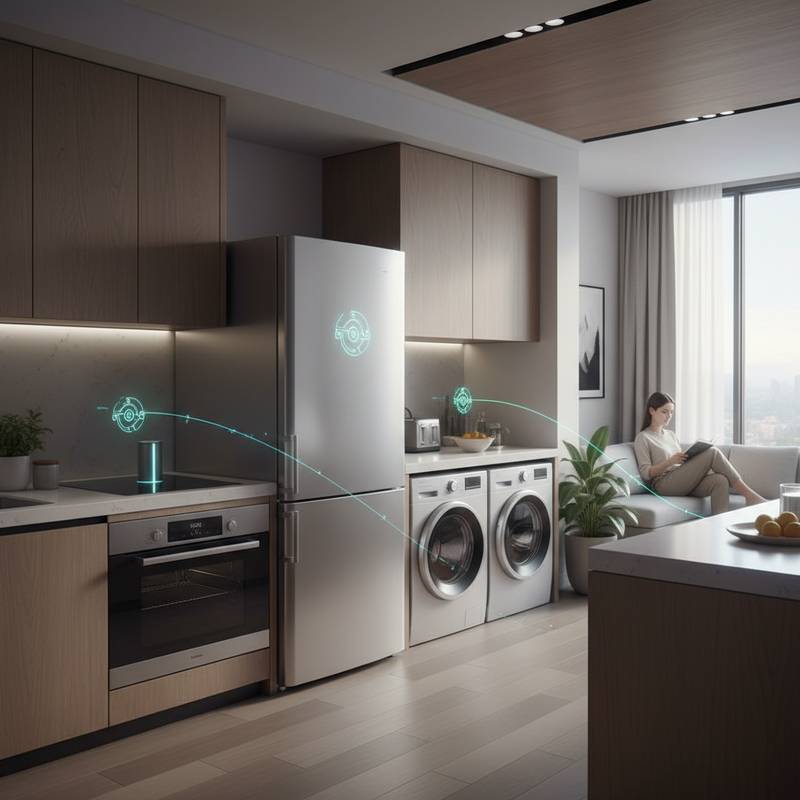Interconnected Smart Appliances Enable Seamless Home Coordination
Picture entering your kitchen following a demanding day. Lights activate gently, the oven begins preheating on schedule, and the dishwasher delays its cycle because the washing machine operates simultaneously. No phone interaction or voice directive occurs. Such scenarios unfold through smart appliances that exchange information independently, crafting an environment attuned to daily rhythms.
Challenges of Traditional Smart Home Management
Many individuals initiate smart home experiences with isolated devices managed via mobile applications. Initial novelty fades as persistent alerts, software updates, and manual activations create fatigue. Users often navigate disparate apps from non-compatible brands, questioning the persistent demand for oversight.
True smart living prioritizes unobtrusive automation. Direct appliance interactions advance this vision by eliminating intermediaries.
Transition to Independent Appliance Networks
Previously, connected devices depended on centralized applications or voice systems. Emerging standards such as Matter, Thread, and Wi-Fi 6 now facilitate secure, direct data sharing without phone or cloud involvement. A washer notifies the dryer of completed loads, a refrigerator alerts the oven to depleted supplies, and a coffee maker initiates brewing upon alarm detection.
This approach emphasizes ease. Operations occur within local networks, yielding quicker responses and reduced privacy risks.
Practical Applications in Daily Routines
View appliances as collaborative components, each fulfilling primary functions while synchronizing with others.
- Direct Network Links: Protocols like Matter or Zigbee enable connections over Wi-Fi or mesh systems.
- Status Exchanges: Sensors relay concise updates on power consumption, temperatures, or operations.
- Predefined Sequences: Linked devices execute routines, such as a dishwasher postponing until solar energy peaks.
- Pattern Recognition: Advanced units adapt over time; an oven may preheat upon kitchen motion after observing consistent evening use.
Examples of Compatible Devices Across Price Ranges
Manufacturers increasingly prioritize such integrations. Consider these options by category:
- Entry-Level: GE Smart Countertop Microwave (approximately 150 dollars). It links locally with GE ranges and sensors, halting if smoke appears or adjusting for humidity levels.
- Mid-Tier: LG ThinQ Smart Refrigerator (approximately 1,400 dollars). Integration with LG ovens and dishwashers via ThinQ allows automated instructions and cycle adjustments for energy balance.
- High-End: Samsung Bespoke AI Laundry Combo (approximately 2,600 dollars). This unit optimizes cycles internally and aligns with Samsung refrigerators or air purifiers for overall efficiency.
Brands vary in methods, yet Matter and Wi-Fi Direct promote cross-compatibility. Matter-certified products simplify multi-brand setups.
Advantages of Localized Operations
A key benefit of direct communication involves durability. External cloud services may fail or alter terms, but local systems persist during internet outages. Enthusiasts often employ compact hubs like the Home Assistant Yellow or Aqara Hub M3 to consolidate devices on private networks, ensuring independence from remote infrastructure.
Establishing Effective Configurations
To surpass app-centric control, verify device specifications for Matter enablement, Thread support, or local automation capabilities.
Follow these steps for a cohesive kitchen or laundry arrangement:
- Inventory Existing Items: Catalog networked appliances and their supported protocols.
- Strengthen Infrastructure: Install a Wi-Fi 6 router or Thread border router for robust connectivity.
- Select Primary Ecosystem: Although Matter aids versatility, focusing on one brand for essentials streamlines processes.
- Build Sequences Incrementally: Begin with oven-hood pairings, then incorporate lighting and climate controls.
- Evaluate and Adjust: Monitor performance and modify triggers to match personal habits.
Financial and Security Factors
Initial costs exceed conventional models, yet long-term savings in time and energy justify expenses. Typical ranges include:
- 150 to 300 dollars for basic items like microwaves or coffee makers.
- 1,000 to 2,000 dollars for refrigerators, ovens, or washers.
- 3,000 dollars or higher for advanced models with sensors, learning algorithms, and full standard compliance.
Professional assistance ensures safe wiring or plumbing integration, preserving warranties. Seek certified experts familiar with smart protocols.
Impacts on Daily Efficiency
Directly communicating appliances foster serene, optimized spaces. Background processes eliminate incessant alerts, conserving time and minimizing waste.
Beyond ease, these systems cultivate adaptive surroundings. Refrigerators timing defrosts for low-demand periods or dryers aligning with solar storage enhance sustainability without ongoing supervision.
Implementing Cohesive Home Systems
Prioritize open standards when upgrading. Opt for dependable, interoperable choices over superficial features. Validate sequences through actual use. Gradually, devices align with lifestyles, reducing phone reliance while elevating comfort.
The essence of phone-independent smart appliances resides in their understated efficiency. Homes evolve from managed entities to intuitive partners, streamlining routines with precision and pleasure.
Frequently Asked Questions
What primary advantage do direct appliance communications offer?
They deliver swift, dependable performance by confining operations to local networks, bypassing cloud delays.
Are dedicated hubs necessary?
Matter devices often function without them, though Thread routers or integrated hubs enhance reliability.
Does functionality persist during internet disruptions?
Local automations continue uninterrupted, while external access temporarily halts.
Is brand mixing feasible?
Yes, provided devices adhere to Matter or compatible open protocols for interoperability.
How secure is data sharing among devices?
Encryption protects local transmissions, confining information to home networks.
Can legacy smart devices participate?
Firmware upgrades enable some; bridging hubs assist others.
How can renters incorporate these features?
Portable plugs, countertop units, and non-invasive sensors provide benefits without alterations.
Where to find details on Matter and local systems?
The Connectivity Standards Alliance offers comprehensive resources on certified devices and protocols.
